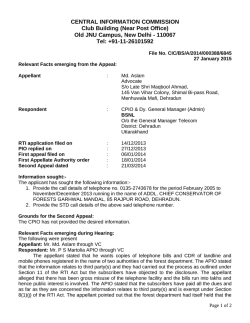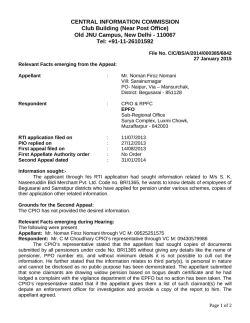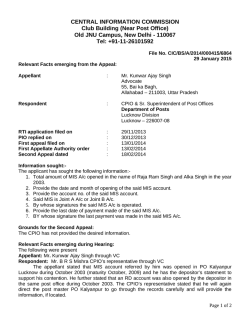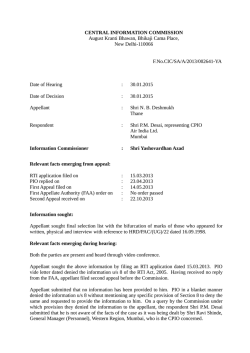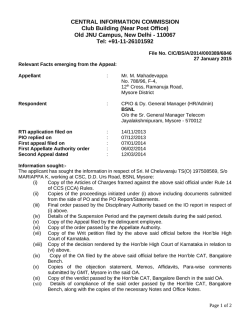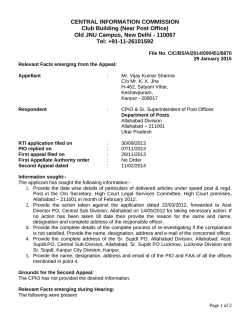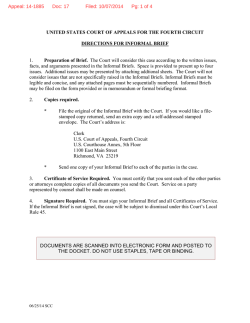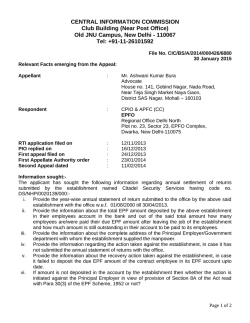
[2012] EWHC 3562 (Admin)
CO/11706/2011
Neutral Citation Number: [2012] EWHC 3562 (Admin)
IN THE HIGH COURT OF JUSTICE
QUEEN'S BENCH DIVISION
THE ADMINISTRATIVE COURT
Royal Courts of Justice
Strand
London WC2A 2LL
Tuesday 13 November 2012
B e f o r e:
MR JUSTICE LEGGATT
Between:
THE QUEEN ON THE APPLICATION OF ALLSOP
Appellant
v
DERBYSHIRE DALES DISTRICT COUNCIL
Respondent
Computer-Aided Transcript of the Stenograph Notes of
WordWave International Limited
A Merrill Communications Company
165 Fleet Street London EC4A 2DY
Tel No: 020 7404 1400 Fax No: 020 7831 8838
(Official Shorthand Writers to the Court)
Mr Richard Kimblin appeared on behalf of the Appellant
Mr Andrew Hogan appeared on behalf of the Respondent
JUDGMENT
(As Approved by the Court)
Crown copyright©
1.
MR JUSTICE LEGGATT: This is an appeal by way of case stated from the Derby
Crown Court which concerns the proper construction of Section 215 of the Town and
Country Planning Act 1990.
2.
The appellant Mr Allsop is a farmer at Brassington, a village in the Derbyshire Dales.
His farm includes a field, one corner of which Mr Allsop has in recent years used for
storing his agricultural trailers. The respondent to this appeal is Derbyshire Dales
District Council ("the council").
3.
On 13 August 2008 the council wrote a letter to Mr Allsop which referred in the
heading to the Town and Country Planning Act and to "unsightly trailers situated in a
field", that being a reference to the field I have already mentioned. The letter stated:
"The council has received complaints regarding a trailer that has been
parked on your land in Brassington. The council considers that the
storage of vehicles on this site has an adverse effect on the amenity of the
area and this has been confirmed by council officers who have visited the
area. In these circumstances, I must ask you to undertake the following
works within 21 days from the date of this letter, to abate the nuisance
and bring the property back to an acceptable standard:
cease the use of the land for storage of vehicles, trailers.
I advise that failure to comply with this request will leave the council with
no option but to consider action pursuant to Sections 215 to 219 of the
Town and Country Planning Act ..... "
Enclosed, in what was said to be "a first step towards instigating formal proceedings",
was a requisition for information.
4.
When Mr Allsop received this letter he instructed solicitors. They replied to the council
on his behalf on 26 August 2008. They produced the information which had been
requested by the council but also stated that they were instructed that the only trailers in
the field were used for the purposes of agriculture. They further said:
"Since the parking of these agricultural trailers is considered to have an
adverse effect on the amenity of the area, our client would be prepared to
erect an agricultural building on the land to facilitate the storage of such
agricultural implements out of sight of neighbouring properties."
5.
The council's head of Planning Services Mr Wilson responded on 1 September 2008
confirming that the Local Planning Authority maintained that the vehicles and trailers
situated at the location "continue to have an adverse effect on the amenities of the area".
As regards the suggestion of erecting an agricultural building, he said that any
application to erect such a building would be treated on its own merits.
6.
That letter was followed by the service of a notice by the council under Section 215 of
the Act. The notice was dated 27 October 2008 and was served on 6 November 2008.
SMITH BERNAL WORDWAVE
It is the effect of this notice which is in issue on this appeal. The notice was addressed
to Mr Allsop, and stated as follows:
"1 This is a formal notice which is served by the council under Section
215 of the above Act because it appears to them that the amenity of a part
of their area is adversely affected by the condition of the land described
below.
2 The land to which this relates The land edged red on the attached plan being land at Brassington,
Derbyshire.
3 What you are required to do The council requires the following steps to be taken for remedying the
condition of the land:
(1) cease the use of the land for storage of vehicles and trailers
4 Time for compliance Step 1 above to be complied with in full within 21 days of the date on
which this notice takes effect.
5 When this notice takes effect This notice takes effect on Friday 28 November 2008."
7.
Section 215 of the Act, under which the notice was purportedly served, provides:
"(1) If it appears to the local planning authority that the amenity of a part
of their area, or of an adjoining area, is adversely affected by the
condition of land in their area, they may serve on the owner and occupier
of the land a notice under this section.
(2) The notice shall require such steps for remedying the condition of the
land as may be specified in the notice to be taken within such period as
may be so specified."
8.
By Section 216 (2) of the Act "(2) If any owner or occupier of the land on whom the notice was served
fails to take steps required by the notice within the period specified in it
for compliance with it ..... "
he is guilty of a criminal offence and liable on summary conviction to a fine.
9.
Section 217 (1) provides for a right of appeal to the Magistrates' Court against a Section
215 notice on any of the following grounds:
SMITH BERNAL WORDWAVE
"(a) that the condition of the land to which the notice relates does not
adversely affect the amenity of any part of the area of the local planning
authority who served the notice, or of any adjoining area;
(b) that the condition of the land to which the notice relates is attributable
to, and such as results in the ordinary course of events from, the carrying
on of operations or a use of land which is not in contravention of Part III;
(c) that the requirements of the notice exceed what is necessary for
preventing the condition of the land from adversely affecting the amenity
of any part of the area of the local planning authority who served the
notice, or of any adjoining area;
(d) that the period specified in the notice as the period within which any
steps required by the notice are to be taken falls short of what should
reasonably be allowed."
Sub-section (5) provides:
"(5) On the determination of such an appeal the magistrates' court shall
give directions for giving effect to their determination, including, where
appropriate, directions for quashing the notice or for varying the terms of
the notice in favour of the appellant."
10.
Section 218 of the Act makes provision for a further appeal against a decision of the
Magistrates' Court to the Crown Court.
11.
Mr Allsop appealed against the notice served on him to the Magistrates' Court. His
appeal was supported by a witness statement dated 22 December 2008 in which it was
argued that parking agricultural trailers was a use of the land in question which was not
in contravention of Part III of the Act, that the condition of the land to which the notice
related was attributable to that use and that he was therefore entitled to appeal under
Section 217 (1) (b) of the Act.
12.
In response, the council served a witness statement from the head of Planning Services,
Mr Wilson, dated 16 January 2009. In that statement Mr Wilson said at paragraph 5:
"5 I must say that at the initial stage my view was very much similar to
the appellant's submission that the vehicles were likely to be agricultural
in nature and I agree that were this case as it appeared on a prima facie
basis then the council could not have taken action."
However Mr Wilson went on to explain that the council's complaint related to what he
described as a "lurid face" painted on the side of one particular trailer which was parked
alongside the wall of the field that faced directly into the Brassington conservation area.
At paragraph 10 Mr Wilson said:
"10 The terms of the notice required the removal of vehicles and trailers
from the area as the harm to the amenity arose from the storage of
SMITH BERNAL WORDWAVE
vehicles in that place facing directly into a conservation area. The council
would not seek to require the appellant to livery his vehicles in a specific
way and took the view that the removal of the vehicles from that location
was the least onerous way of ensuring that the harm to the amenity was
resolved."
13.
Mr Allsop subsequently made a further witness statement in which he said that he had
not been aware that the council's complaint was directed at the face painted on the side
of the trailer until after a telephone conversation had taken place between his solicitor
and the solicitor for the council on 15 January 2009. He further said that he would have
no hesitation in over-painting the face and if anybody at any time had asked him to do
so he would have done that earlier. He stated that on the next day - in other words 16
January 2009 - he did in fact take some paint and paint over the face, thus addressing
the matter about which the council was concerned.
14.
Despite this, the dispute continued because Mr Allsop took the view that there had been
no valid legal basis for the notice served on him whereas the council insisted that there
was. Mr Allsop's appeal against the notice was heard by the Chesterfield Magistrates'
Court which, on 4 March 2009, dismissed the appeal. Mr Allsop then exercised his
right of further appeal to the Crown Court.
15.
On 12 July 2010 the council issued a summons to prosecute Mr Allsop for failure to
comply with the notice. It is accepted however that this summons was issued in error
by the council and it was subsequently withdrawn.
16.
The appeal to the Crown Court was heard on 24 June 2011 by Her Honour Judge
Watson, sitting with two lay justices. Again, the appeal was dismissed. In her full and
clear judgment, Judge Watson said - addressing an argument that the notice did not
clearly set out within the four corners of the document the description of the problem,
the reason for the notice or any consideration of why the remedying requirements were
set out "We are satisfied that the notice issued, although brief, was nevertheless
directive and clear, and, further, that it complied with the requirements set
out under Section 215 and the Sections that follow."
17.
The Crown Court also rejected a second ground of appeal based on Section 217 (1) (b),
which is described as the "farming defence", being an argument that the notice was
invalid because the condition of the land which it required Mr Allsop to remedy was
attributable to and resulted, in the ordinary course of events, from a use of the land
which was not in contravention of Part III in circumstances where - it was common
ground - agricultural use was not a contravention of Part III. The judge said:
"That second ground of appeal, which would, we find, succeed in relation
to those used clearly and obviously as agricultural trailers, does not apply
to the silage cart with a lurid face on it, which was parked alongside the
wall, parallel to the road, positioned opposite and in full view of the
Brassington conservation area.
That vehicle, parked as it was,
SMITH BERNAL WORDWAVE
particularly offends the eye and adversely affects the amenity of the land
..... There is no agricultural use or purpose to the unsightly face."
The judge concluded this section of her judgment by stating:
"We are satisfied that this lurid face was graffiti which adversely affected
the amenity of the land."
18.
Finally, the Crown Court considered a third ground of appeal based on Section 217 (1)
(c) of the Act that the notice " ..... was draconian, as it requires cessation of the use of the whole parcel
of land for storage of vehicles and trailers."
The court agreed that that was the effect of the notice and that it was too widely
worded, as indeed had been conceded by the council in connection with the appeal.
However the council had proposed in a letter written in January 2011 and in their
skeleton argument for the appeal that the notice should be amended by adding to the
statement of what Mr Allsop was required to do the words "bearing unorthodox livery"
so that the wording of that section of the notice would read "cease the use of the land
for storage of any vehicles or trailers bearing unorthodox livery".
19.
On that basis the Crown Court concluded that the council had properly issued a Section
215 notice which was justified in fact and in law and that the appeal should be
dismissed on the basis that the notice would be varied in the way that I have just
described.
20.
Following this decision, Mr Allsop applied to the Derby Crown Court to state a case.
The Crown Court has duly done so in accordance with a transcript of the judgment and
has sought the opinion of the High Court on the following question:
"Did we correctly construe the scope of Section 215 of the Town and
Country Planning Act 1990?"
21.
On this appeal Mr Kimblin, who appears for Mr Allsop, accepted that the council
would have been entitled to serve a Section 215 notice which required the removal of a
face painted on a trailer because it harmed the amenity of the neighbouring land. But
he submitted that the notice in fact served by the council was invalid for three reasons.
22.
The first ground of the appeal can be summarised as follows. Certain uses of land or
material changes in the use of land require planning permission. There is a regime
which governs the grant of planning permission and the action that may be taken where
there has been a breach of planning control. That regime is contained in Parts III and
VII of the 1990 Act. In particular, Section 172 of the Act gives a local planning
authority power to issue an enforcement notice where there appears to have been a
breach of planning control, which includes the situation in which there has apparently
been a use of land which contravenes Part III of the Act. There are formal requirements
with which such notice must comply and there is provision for appeal to the Secretary
of State against such an enforcement notice, the reason for this being that the Secretary
SMITH BERNAL WORDWAVE
of State may appoint a planning inspector who would have the relevant expertise to
determine questions which may arise in that context.
23.
In addition, a local planning authority has a power under Section 102 of the Act, if it
appears to the authority that it is expedient in the interests of proper planning of their
area, including the interests of amenity, to require by order the discontinuance of any
use of land. Furthermore, Section 115 provides that where such an order is made the
local planning authority must pay compensation to any person who is shown to have
suffered damage in consequence of the order.
24.
Mr Kimblin submits that the scheme of the planning legislation must be interpreted as a
whole and that on such a holistic view cessation of a use of land is a matter which is
controlled exclusively by Parts III and VII of the Act. Section 215, he submits, should
not be construed in such a way that it allows a local authority to circumvent the
requirements which apply under Parts III and VII in relation to planning control. That
would be the case, he says, if a Section 215 notice could be employed to require a
particular use of land to cease, as did the notice served here. Accordingly, Mr Kimblin
submitted, on the proper construction of Section 215 that section cannot be invoked to
require an owner or occupier of land to cease using the land for a particular purpose.
25.
In response to that argument, Mr Hogan submitted that under the Act a local planning
authority has a set of powers and tools at its disposal which are not necessarily mutually
exclusive so that there may be more than one that is available in any particular factual
situation. In those circumstances, he submitted, it is a matter for the local authority to
choose which power to invoke and there may be a situation in which the local authority
would be entitled to proceed either under Section 215 or under one of the other sections
to which I have referred. There is nothing, he submitted, which requires the Act to be
construed in a way which precludes the local authority from following the Section 215
route in such circumstances.
26.
I do not find it necessary to decide whether Part III of the Act is a comprehensive code
for regulating the use of land such that a Section 215 notice can never be employed to
require a particular use of land to cease. It may be the case that, as Mr Kimblin
submitted, on a proper construction of the Act, in circumstances where a use of land
contravenes Part III of the Act, the only power which can properly be invoked is an
enforcement notice rather than a Section 215 notice. It is not however necessary for me
to decide that question as it is not suggested that in this case Mr Allsop was using the
land in question in a way which contravened Part III. That situation therefore does not
arise.
27.
Mr Kimblin however also made a narrower submission as or as part of his third ground
of appeal to the effect that where, as here, the land in question is not being used in a
way which is said to contravene Part III, Section 215 is not to be construed as
authorising the service of a notice under that section which requires the cessation of
such lawful use. That conclusion does seem to me to follow from the express wording
of Section 217 (1) (b). Put in terms of this case, the Section 215 notice, as varied by the
Crown Court, required Mr Allsop to cease the use of the land for storage of vehicles
and trailers bearing unorthodox livery. It is not however suggested that the use of the
SMITH BERNAL WORDWAVE
land for storage of vehicles and trailers bearing unorthodox livery is a use which
contravenes Part III of the Act. On a fair reading of the notice it seems to me plain that
the description of what Mr Allsop was required to do also defines the condition of the
land about which complaint was made. It follows, in my view, that the condition of the
land to which the notice relates is attributable to, and such as results in the ordinary
course of events from, a use of land which is not in contravention of Part III.
28.
I would add that Section 217 (1) (b) is also entirely consistent with the fact that the Act
provides in Section 102 a different power which is applicable in circumstances where
the relevant use of the land is lawful and it would, as it seems to me, cut across Section
102 - read in conjunction with Section 115 which provides for compensation where an
order is made for a previously lawful use to be discontinued - if Section 215 could be
construed in a way which allowed Section 215 to be used for such a purpose.
29.
The second ground of this appeal advanced by Mr Kimblin is that the notice was
invalid because it failed adequately to communicate the nature of the council's
complaint. In the case of an enforcement notice under Section 172 there are express
provisions set out in Section 173 of the Act and in further statutory regulations which
stipulate the required content of such a notice. There are no corresponding provisions
in the case of a notice issued under Section 215. Nevertheless, I consider - and I do not
understand Mr Hogan to dispute - that, as a matter of general principle, such notice in
order to be valid must identify the condition of the land about which complaint is made
and the steps required to remedy that condition with sufficient clarity to enable the
recipient of the notice fairly to understand the nature of the complaint and exactly what
it is that he must do in order to comply with the notice. That is a basic requirement of
fairness and natural justice. And it must be presumed that Parliament intended the local
planning authority to exercise the power conferred by Section 215 in accordance with
requirements of natural justice.
30.
It is all the more important that those requirements be satisfied and they are all the more
clearly to be applied in circumstances where failure to take steps required by a notice
under Section 215 is a criminal offence.
31.
The clear import of the notice served in this case was that it was the use of the land
described in the notice for the storage of vehicles and trailers which was the subject of
the complaint and that in order to comply with the notice it was necessary for Mr
Allsop to stop using the land altogether for such storage. It was only in January 2009 some time after the notice had been served - that the council made it clear that its real
complaint was not about the use of the field to store vehicles and trailers but the fact
that one trailer with a lurid face painted on it had been parked alongside the boundary
wall of the field in that particular location where it harmed the amenity of the
neighbouring land.
32.
Mr Hogan submitted that the Crown Court correctly found that the notice was clear on
its face in terms of the condition of the land about which complaint was made and what
Mr Allsop was required to do to remedy the position. He submitted that in those
circumstances there was no error of construction of Section 215 and that the Crown
Court was entitled to find that there was a valid Section 215 notice at the outset albeit
SMITH BERNAL WORDWAVE
that the notice was subject to criticism for being too broadly drawn, which situation the
Crown Court considered could properly be addressed by varying the terms of the
notice.
33.
It seems to me however that the Crown Court erred not in finding that the notice as
served was clear but in failing to ask a further question, namely whether the notice gave
fair notification of the problem which it was being used to remedy, namely the presence
of graffiti on the side of the trailer parked on the boundary of the land. Had that
question been asked, the only answer which in my view could reasonably have been
given is "no". The recipient of the notice would not reasonably understand it to be
making that complaint but rather the more general one, that the problem to be rectified
was the storage of vehicles and trailers in the field per se.
34.
To identify the error of construction which in my view the Crown Court made, the
court, as I see it, erred in construing Section 215 as allowing a notice under that section
to be used for a purpose or to achieve a result the substance of which is not reasonably
apparent from the notice itself. Mr Hogan acknowledged that the notice could perhaps
have been better drafted but, he said, it was only intended to stop Mr Allsop from
painting graffiti on vehicles parked on the land - from repeating in effect what he did in
the summer of 2008. It is apparent that that was indeed the intention that underlay the
service of the notice but the objection is not merely that the notice could have been
better drafted but that the notice, in the form that it was served, did not adequately or
properly identify the substance of the mischief at which it was directed.
35.
In those circumstances the notice served was in my view one which clearly fell outside
the powers conferred by Section 215 and, in circumstances where it was purportedly a
criminal offence not to comply within twenty-eight days with that invalid notice, I do
not think that the section can be construed as allowing the notice thereafter to be saved
by a variation made under Section 217 (5).
36.
In conclusion, to answer the question raised on the case stated, I would respectfully
give the answer "no" for two reasons. First, the Crown Court ought to have construed
Section 215 as affording no power to the Secretary of State to issue a notice which
required the cessation of a use of land which did not and was not said to contravene
Part III of the Act; and second, the Crown Court ought to have construed Section 215 as
affording no power to the Secretary of State to issue a notice which failed clearly or at
all to identify the substance of the mischief at which it was directed, being in this case
not the use of the land in question to store vehicles and trailers but the presence of
graffiti on a particular trailer parked along the boundary of the land.
37.
MR KIMBLIN: I am grateful. May I canvass with my Lord the consequent order that
might flow from your judgment? First, in respect of the notice - I do not think there is
any dispute in that regard - can I ask that the notice be quashed?
38.
MR HOGAN: There is no dispute on that.
39.
MR KIMBLIN: There are two orders which I seek in respect of the costs: the first in
respect of costs of these proceedings on the case stated and, secondly, in respect of such
SMITH BERNAL WORDWAVE
costs orders as there are below that those orders be quashed and in their place there be
an order that essentially there be costs of today and Mr Allsop's costs below. That is
the costs order which I seek in overview. In that regard, may I hand up to my Lord a
copy of City of Bradford Metropolitan Borough Council v Booth High Court [2001]
164 JP 485.
40.
MR JUSTICE LEGGATT: I have read that.
41.
MR KIMBLIN: You will have two authorities, Bradford and R v Cambridge City
Council v Nestling [2006] EWHC 1374. Nestling comes second in time and
encapsulates Bradford within it. I ask you to look at paragraph 8 of the judgment.
42.
MR JUSTICE LEGGATT: Has there been a more recent authority at the Court of
Appeal? We will look at the matter. Shall I read paragraphs 8 and 9?
43.
MR KIMBLIN: I would be grateful. (Pause) I have some submissions to make about
that general approach. The essence of the approach is, first, to admit of costs following
the event. That is my starting point. I would invite the court to make an order that
costs do follow the event. But that needs to be seen in the context of what is at
paragraph 3 of what Lord Bingham had to say in Bradford.
44.
MR JUSTICE LEGGATT: This is dealing with Section 64 of the Magistrates' Court
Act.
45.
MR KIMBLIN: Yes, which is what would be applicable below - - - - -
46.
MR JUSTICE LEGGATT: - - - - - and in the Crown Court as well?
47.
MR KIMBLIN: Yes, essentially, in the sense that matters of this sort are dealt with
according to these principles.
48.
The first point I would like to deal with in the third paragraph of Lord Bingham's
approach is "financial prejudice to the particular complainant", and the second point is
"the need to encourage public authorities to make and stand by honest, reasonable and
apparently sound administrative decisions made in the public interest without fear of
exposure to undue financial prejudice". I deal with them in order.
49.
In respect of financial prejudice to Mr Allsop, you will observe that it has been
necessary for there to be three appeals to deal with this notice. I do not have to mind
what the sum involved is but it is quite a lot of money. In the context of your judgment
and submissions you have heard, it is relevant to point out that the procedure under Part
VII is one which is a starting point of being costs free but that if there is unreasonable
conduct by one party then an award of costs may be made by the Secretary of State. In
this case I submit that where there has been the need to pursue this appeal now three
times when - before the appeals were heard - it was clear that the council's concern was
the face, we still have not had an explanation from the council as to why it continued to
resist the appeals. It is quite extraordinary that Mr Allsop has had to pursue this appeal
to this court when apparently long, long ago the matter of complaint was dealt with
within twenty-four hours of him fully understanding it.
SMITH BERNAL WORDWAVE
50.
MR JUSTICE LEGGATT: Are you saying that the council acted unreasonably or are
you accepting it acted reasonably and then arguing that these circumstances come into
play?
51.
MR KIMBLIN: I accept that the council was reasonable to say to Mr Allsop sort out
the smiley face. The starting point as to making some form of intervention was
reasonable.
52.
What is unreasonable, in my submission, is what has been done thereafter which is the
proceedings. The proceedings which Mr Allsop has been forced to go through are
completely unreasonable because that which was sought was done but the council still
maintained its position and then lost on the basis of a notice which my Lord has found
to have been invalid in parts on the basis that the notice did not say what is was
supposed to say. In my submission, if there is to be real meaning and effect given to
the principles of fairness and natural justice, if a public body says one thing when it
means something completely different and puts the individual through three appeal
processes to seek to come to the position we have come to, the only fair and just
outcome is that the recipient of the notice is put back into the position he would have
been in if the council had said what is meant.
53.
I submit (1) it was unreasonable to continue to resist when there had been a resolution
of the real issues, and (2) to have persisted in respect of something where, from the
outset, the council has been put on notice as to the point on which ultimately he has
been successful. If we consider points (1) and (2) together, the prejudice is substantial.
In this case there is no question of a planning authority being discouraged from taking
honest, reasonable and sound administrative decisions because in this case the decision
which was made to serve that particular notice was wholly misleading and the decision
to defend it was thoroughly unsound and in nobody's interest at all. If one thinks back
to when my Lord introduced [in] your judgment as to what happened at the outset, what
Mr Allsop was told, what happened when he in fact found out what he needed to do, it
is a position which ought never to have resulted.
54.
My last point would be that this is an argument which never really ought to have been
necessary. Any planning authority should be taken to understand the various provisions
which are in the Act, and in this case rather by-passed those which is in itself
unreasonable.
55.
Those are my submissions in respect of costs. In the event that Mr Hogan has anything
to say about that, no doubt I will have the opportunity to reply.
56.
MR HOGAN: The order I seek is no order for costs here and below. You have
Nestling. It is quite apparent from paragraph 9 - where Lord Bingham's principles are
set out - and paragraph 11 that Nestling applies Lord Bingham's principles more
generally to this area of regulatory intervention by local authorities.
57.
The point that is being made is when one looks at making costs orders against the local
authority the touchstones are unreasonableness and acting in bad faith. When one
considers bad faith there is no allegation here that the council has acted in bad faith.
SMITH BERNAL WORDWAVE
When one considers unreasonableness it must be the subjective belief of the council
because otherwise, if it were objective, in every case when the council loses because it
is corrected by the court an order for costs would follow on the basis of
unreasonableness. If one looks at what Lord Bingham was saying in paragraph 3 (ii),
that is the court's interpretation because he said there is a "need to encourage public
authorities to make and stand by honest, reasonable and apparently sound
administrative decisions made in the public interest without fear of exposure to undue
financial prejudice if the decision is successfully challenged."
58.
Over the page at paragraph 12 the point is made:
"As to the financial loss suffered by the successful appellant, a successful
appellant who has to bear his own costs will necessarily be out of pocket,
and that is the reason in ordinary civil litigation for the principle that costs
follow the event. But that principle does not apply in this type of case.
When Lord Bingham referred to the need to consider the financial
prejudice to a particular complainant in the particular circumstances, he
was not in implying that an award for costs should ..... follow ..... quite to
the contrary."
59.
The long and short of it is that the reality of the matter is that Mr Allsop acted wrongly
(I use that term with a degree of imprecision deliberately) in placing graffiti on this land
in the vicinity of a conservation area. All the council has tried to do is (a) ensure the
removal of the graffiti and (b) make sure it is not replaced through the maintenance of a
notice which you have found should not have been issued in the form that it was but
that it would have been perfectly proper to issue a notice somewhat narrower in scope.
Against that backdrop and in circumstances where of course there is financial prejudice
to Mr Allsop, but equally my client is in somewhat straitened circumstances in that it is
making year-on-year austerity-driven reductions at the current time, the fair order is no
costs here and below.
60.
MR KIMBLIN: Austerity cuts both ways.
61.
So far as my friend's points are concerned, objective and subjective reasonableness,
with respect to him in my submission it is absolutely obvious that one is concerned here
with whether or not in your view it was reasonable for the council to serve such a notice
when it meant something else and then to defend it in the context of the points which
have been made right from the outset. If it is necessary to do so I can go to the skeleton
arguments in due course below, those points being made right from the outset, and it
has defended its position to the hilt. It had a choice as to whether or not to do that and
whether or not to put Mr Allsop to further expense.
62.
MR JUSTICE LEGGATT: If I were to make an order for costs, how would the costs
be assessed?
63.
MR KIMBLIN: I have an eye on the time. Detailed assessment is being whispered
across the Bar. I would ask for either or both a period for the parties to discuss the
quantum of any order that is made, failing which there be detailed assessment.
SMITH BERNAL WORDWAVE
64.
MR JUSTICE LEGGATT: The order encompasses costs in the Magistrates' Court and
the Crown Court. Does that fall within the detailed assessment provisions of the Civil
Procedure Rules?
65.
MR KIMBLIN: May I seek some assistance in that regard? (Pause) We agree that we
can do a detailed assessment in respect of today, but below we are in some difficulty in
finding the power to deal with detailed assessment of those costs which leaves me with
a fall-back position of inviting a period for the parties to discuss matters and then to
make written submissions to you if there is dispute on quantum.
66.
MR HOGAN: Costs in this court would fall to be dealt with by a LSCO. Any quantum
of a costs order below would be dealt with by the mechanism in the Criminal Procedure
Rules and the Crown Court has its own mechanism for assessing costs.
67.
MR JUSTICE LEGGATT: They would need to be assessed by the Crown Court,
would they?
68.
MR HOGAN: Yes. It has its own rules set out in the Criminal Procedure Rules.
Oddly, although this is a civil appeal, it is the Criminal Procedure Rules which would
apply in the Crown Court.
69.
MR JUSTICE LEGGATT: Although the passage from Lord Bingham's judgment
indicates that it is this court taking a view about not only the existence but the quantum
of costs that ought to be paid.
70.
MR HOGAN: Yes. I suspect what Lord Bingham may have had in mind is not just the
pounds and pence but the fact that there is always discretion to make a proportionate
costs order as a sort of halfway house.
71.
MR JUSTICE LEGGATT: It does seem to me right that the council should pay costs
in this case because I do consider it follows from the findings that I have made in my
judgment that it did act unreasonably in seeking to uphold a notice which, in my view,
was wholly deficient for the reasons I have given.
72.
In the circumstances what I propose to do is to make an order in principle for Mr
Allsop's costs to be paid. But in terms of how those costs are to be assessed if they
cannot be agreed, I would invite the parties to seek to agree the quantum of costs and
failing that the manner in which the assessment should be made. If there is any dispute
about either of those matters, please refer to me in writing.
73.
MR KIMBLIN: I am grateful. I shall endeavour during the course of tomorrow to
provide a draft order in those terms and agree.
74.
MR HOGAN: I think counsel will be able to agree the order.
75.
There is a further matter about which I must trouble your Lordship. There are very few
authorities on Section 215, none of which are remotely applicable to the facts of this
case. The approach that your Lordship has taken breaks new ground. In those
SMITH BERNAL WORDWAVE
circumstances I ask for permission to appeal to the higher court in order to take this
matter further.
76.
MR KIMBLIN: Section 28A of the Senior Courts Act deals with appeal provisions
from this court, and there is not one. There is no right of appeal from this court. There
is no right of appeal.
77.
MR JUSTICE LEGGATT: That is right, is it?
78.
MR HOGAN: I would need to check that.
79.
MR JUSTICE LEGGATT: I will say if the application for permission to appeal is to be
pursued it should be done in writing by way of a written submission.
80.
MR HOGAN: May I have fourteen days to put that in?
81.
MR JUSTICE LEGGATT: Yes. I think I should ask you if it could be more swift than
that. It really depends on checking the point, does it not, whether there is power to
grant permission? And if so, perhaps you could put something in quite shortly.
82.
MR HOGAN: Yes. The only point I was going to make was if there is a power and the
application is pursued, I would want to put in something in writing rather than simply
asking because - - - - -
83.
MR JUSTICE LEGGATT: You want to put in a proper submission.
84.
MR HOGAN: Yes.
85.
MR JUSTICE LEGGATT: In that case fourteen days seems appropriate, Mr Kimblin?
86.
MR KIMBLIN: Very well.
87.
MR JUSTICE LEGGATT: If you want to put in anything in opposition - either on a
point of principle or whether on permission should be granted - then you should have
further time to do so.
88.
MR KIMBLIN: May I ask for seven days?
89.
MR JUSTICE LEGGATT: Yes, within which you either indicate it is nothing, it is a
non-return or there is a return - to put one in. That can be incorporated in the order.
---
SMITH BERNAL WORDWAVE
© Copyright 2025
